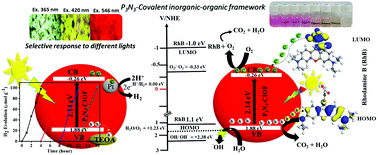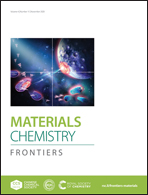Cyclotriphosphazene (P3N3) hybrid framework for aggregation induced photocatalytic hydrogen evolution and degradation of rhodamine B†
Abstract
The utilization of solar energy is an epitome towards water splitting for hydrogen generation and environmental remediation. For efficient use of solar energy, photocatalysts capable of light-harvesting, with appropriate band energetics, that are inexpensive, stable, and scalable, are desired. Herein, a prototypical cyclotriphosphazene (P3N3)-based covalent inorganic–organic hybrid framework (CIOF) is designed with highly crosslinked aggregation that can produce hydrogen fuel from photocatalytic water splitting, as well as the degradation of industrial waste-water pollutant (rhodamine B). The P3N3-CIOF was synthesized by the aggregation, self-assembly, and subsequent polycondensation of hexachlorocyclotriphosphazene, tris(4-hydroxyphenyl)ethane and pyridine, in one-pot under ultrasonication. Morphology and structure of the newly synthesized P3N3-CIOF are characterized through scanning electron microscopy, Fourier transform infrared spectroscopy, solid-state 31P and 13C nuclear magnetic resonance spectroscopy, X-ray photoelectron microscopy, UV-visible absorbance, photoluminescence, and micro-spectrophotometry. The P3N3-CIOF shows selective response to the UV-visible light by emitting bright green (Ex. 365 nm), yellow (Ex. 420 nm), and red (Ex. 546 nm) colors. Moreover, the onset bandgap (2.14 eV) and the potential of the conduction band (−0.26 eV) and valence band (+1.88 eV) straddle the potential range for photocatalytic water splitting and dye degradation. The as-synthesized P3N3-CIOF continuously produced hydrogen fuel (24.5 μmol g−1 h−1) during photocatalytic water splitting for a period of 16 h, using Pt (3 wt%) and triethanolamine as the co-catalyst and holes scavenger, respectively. It also showed photodegradation ability to rhodamine B as a proxy dye to industrial waste-water pollutants. The plausible photocatalytic mechanism is also proposed based on the energetics of the photogenerated excitons, and scavenging experiments. These findings exemplify a critical first step towards photocatalytic hydrogen generation and remediation of organic pollutants through P3N3-CIOF, as well as motivation to engineer new materials based on aggregation-induced phenomena.



 Please wait while we load your content...
Please wait while we load your content...